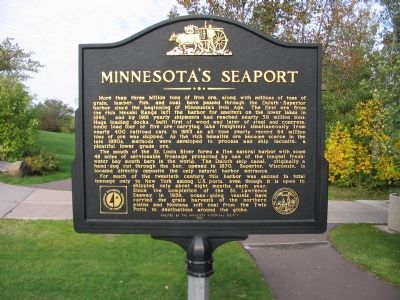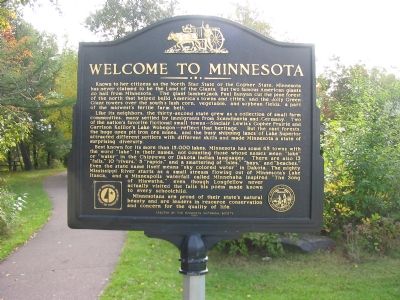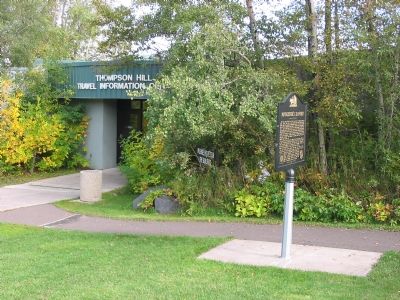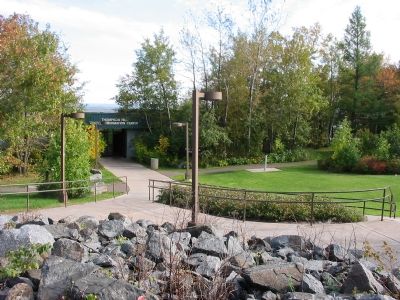West Duluth near Proctor in Saint Louis County, Minnesota — The American Midwest (Upper Plains)
Minnesota’s Seaport / Welcome to Minnesota
The mouth of the St. Louis River forms a fine natural harbor with some 49 miles of serviceable frontage protected by one of the longest freshwater bay mouth bars in the world. The Duluth ship canal, originally a hand-dug cut through the bar, opened in 1870. Superior, Wisconsin, is located directly opposite the only natural harbor entrance.
For much of the twentieth century this harbor was second in total tonnage only to New York among U.S. ports, even though it is open to shipping only about eight months each year. Since the completion of the St. Lawrence Seaway in 1959, ocean-going vessels have carried the grain harvests of the northern plains and Montana soft coal from the Twin Ports to destinations around the globe.
Welcome to Minnesota. Known to her citizens as the North Star State or the Gopher State, Minnesota has never claimed to be the Land of the Giants. But two famous American giants do hail from Minnesota. The giant lumberjack Paul Bunyan cut the pine forest of the north that helped build America’s towns and cities, and the Jolly Green Giant towers over the south’s lush corn, vegetable, and soybean fields, a part of the midwest’s fertile farm belt.
Like its neighbors, the thirty-second state grew as a collection of small farm communities, many settled by immigrants from Scandinavia and Germany. Two of the nation’s favorite fictional small towns—Sinclair Lewis’s Gopher Prairie and Garrison Keillor’s Lake Wobegon—reflect that heritage. But the vast forests, the huge open pit iron ore mines, and the busy shipping lanes of Lake Superior attracted different settlers with different skills and made Minnesota a state of surprising diversity.
Best known for its more than 15,000 lakes, Minnesota has some 65 towns with the word “lake” in their names, not counting those whose names mean “lake” or “water" in the Chippewa or Dakota Indian languages. There are also 13 “falls,” 10 “rivers,” 5 “rapids,” and a smattering of “isles,” “bays,” and “beaches.” Even the state name itself means “sky colored water” in Dakota. The mighty Mississippi River starts as a small stream flowing out of Minnesota’s Lake Itasca, and a Minneapolis waterfall called Minnehaha inspired “The Song of Hiawatha,” even though Longfellow never actually visited the falls his poem made known to every schoolchild.
Minnesotans are proud of their state’s natural beauty and are leaders in resource conservation and concern for the quality of life.
Erected 1987 by the Minnesota Historical Society.
Topics and series. This historical marker is listed in these topic lists: Industry & Commerce • Settlements & Settlers • Waterways & Vessels. In addition, it is included in the Minnesota Historical Society series list. A significant historical year for this entry is 1892.
Location. 46° 43.765′ N, 92° 12.346′ W. Marker is near Proctor, Minnesota, in Saint Louis County. It is in West Duluth. Marker can be reached from Interstate 35 at milepost 249, on the left when traveling north. Marker is at Thompson Hill Travel Information Center/Rest Area (about 7 miles southwest of downtown Duluth). Exit at South Boundary Avenue (County Road 14), to Westgate Boulevard, then to Thompson Hill Visitors Center Parkway. The rest area can be reached from both directions on Interstate 35. Touch for map. Marker is in this post office area: Duluth MN 55810, United States of America. Touch for directions.
Other nearby markers. At least 8 other markers are within 5 miles of this marker, measured as the crow flies. Geology of Duluth Harbor (within shouting distance of this marker); The Gate (within shouting distance of this marker); Gonyea, Verville and National Guardsmen Memorial (approx. 1.2 miles away); Engine 225 (approx. 1.3 miles away); Oneota (approx. 3.4 miles away); Rice's Point (approx. 5 miles away); Summer White House - 1928 (approx. 5 miles away in Wisconsin); Rotary Club of Duluth International Service Projects (approx. 5 miles away). Touch for a list and map of all markers in Proctor.
Credits. This page was last revised on February 12, 2023. It was originally submitted on October 22, 2007, by Keith L of Wisconsin Rapids, Wisconsin. This page has been viewed 2,363 times since then and 10 times this year. Photos: 1. submitted on October 22, 2007, by Keith L of Wisconsin Rapids, Wisconsin. 2. submitted on October 23, 2007, by Keith L of Wisconsin Rapids, Wisconsin. 3. submitted on October 22, 2007, by Keith L of Wisconsin Rapids, Wisconsin. 4. submitted on October 23, 2007, by Keith L of Wisconsin Rapids, Wisconsin. • J. J. Prats was the editor who published this page.



